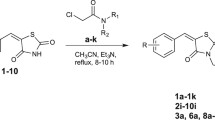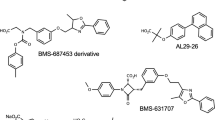Abstract
The development of new antihyperlipidemic agents with higher potency and lower side effects is of high priority. In this study, 1,3,4 thiadiazole Schiff base derivatives were synthesized as potential peroxisome proliferation-activated receptor-α (PPARα) agonists and characterized using elemental analysis, FTIR, 1H-NMR, 13C-NMR and mass spectroscopy and then tested for their hypolipidemic activity in Triton WR-1339-induced acute hyperlipidemic rat model in comparison with bezafibrate. The compounds showed significant hypolipidemic activity. Induced fit docking showed that the compounds are potential activators of PPARα with binding scores − 8.00 Kcal/mol for 2,5-bis(4-hydroxybenzylidenamino)-1,3,4-thiadiazole. PCR array analysis showed an increase in the expression of several genes involved in lipid metabolism through mitochondrial fatty acid β oxidation and are part of PPARα signaling pathway including Acsm3, Fabp4 and Hmgcs1. Gene expression of Lrp12 and Lrp1b involved in LDL uptake by liver cells and Cyp7a1 involved in cholesterol catabolism were also found to be upregulated.







Similar content being viewed by others
References
Ahmad U, Ahmad RS, Arshad MS, Mushtaq Z, Hussain SM, Hameed A (2018) Antihyperlipidemic efficacy of aqueous extract of Stevia rebaudiana Bertoni in albino rats. Lipids Health Dis 17(1):175
Aqeel MT (2018) antihyperlipidemic studies of newly synthesized phenolic derivatives: in silico and in vivo approaches. Drug Des Devel Ther 12:2443
Chandrakantha B, Isloor AM, Shetty P, Fun HK, Hegde G (2014) Synthesis and biological evaluation of novel substituted 1,3,4-thiadiazole and 2,6-di aryl substituted imidazo [2,1-b][1,3,4] thiadiazole derivatives. Eur J Med Chem 71(7):316–323
Patel HM, Noolvi MN, Goyal A, Thippeswamy B (2013) 2,5,6-Trisubstituted imidazo [2,1-b] [1,3,4] thiadiazoles: search for antihyperlipidemic agents. Eur J Med Chem 65:119–133
Matysiak J (2015) Biological and pharmacological activities of 1, 3,4-thiadiazole based compounds. Mini Rev Med Chem 15(9):762–775
Shen L, Zhang Y, Wang A, Sieber-McMaster E, Chen X, Pelton P, Xu JZ, Yang M, Zhu P, Zhou L, Reuman M (2007) Synthesis and identification of [1,2,4] thiadiazole derivatives as a new series of potent and orally active dual agonists of peroxisome proliferator-activated receptors α and δ. J Med Chem 50(16):3954–3963
Jain SK, Mishra P (2014) Appraisal of analgesic and anti-inflammatory activity of some 2,5-disubstituted-1,3,4-thiadiazoles. Int J Curr Microbiol App Sci 3:849–855
Da Silva CM, Da Silva DL, Modolo LV, Alves RB, De Resende MA, Martins CV, De Fátima (2011) Â. Schiff bases: a short review of their antimicrobial activities. J Adv Res 2(1):1–8
Geldenhuys WJ, Lin L, Darvesh AS, Sadana P (2017) Emerging strategies of targeting lipoprotein lipase for metabolic and cardiovascular diseases. Drug Discov Today 22(2):352–365. https://doi.org/10.1016/j.drudis.2016.10.007
Kwon RH, Ha BJ (2014) Protection of Saururus chinensis extract against liver oxidative stress in rats of triton WR-1339-induced hyperlipidemia. Toxicol Res 30(4):291–296. https://doi.org/10.5487/tr.2014.30.4.291
Baldissera MD, Souza CF, Grando TH, Doleski PH, Boligon AA, Stefani LM, Monteiro SG (2017) Hypolipidemic effect of β-caryophyllene to treat hyperlipidemic rats. Naunyn Schmiedebergs Arch Pharmacol 390(2):215–223. https://doi.org/10.1007/s00210-016-1326-3
Hamadneh L, Al-Essa L, Hikmat S, Al-Qirim T, Abu Sheikha G, Al-Hiari Y, Azmy N, Shattat G (2017) N-(3-Benzoylphenyl)-1H-indole-2-carboxamide decreases triglyceride levels by downregulation of Apoc3 gene expression in acute hyperlipidemic rat model. Mol Cell Biochem 431(1–2):133–138. https://doi.org/10.1007/s11010-017-2983-3
Charan J, Kantharia ND (2013) How to calculate sample size in animal studies? J Pharmacol Pharmacother 4:303–306. https://doi.org/10.4103/0976-500X.119726
Al-Najdawi M, Al-Hiari Y, Al-Qirim T, Shattat G, Al-Zweri M, Abu Sheikha G (2014) Synthesis and pharmacological evaluation of novel unsubstituted indole-anthraquinone carboxamide derivatives as potent antihyperlipidemic agents. Z Naturforsch C 69(1–2):21–28
Abu Farha R, Bustanji Y, Al-Hiari Y, Al-Qirim T, Abu Shiekha G, Albashiti R (2016) Lipid lowering activity of novel N-(benzoylphenyl)pyridine-3-carboxamide derivatives in Triton WR-1339-induced hyperlipidemic rats. J Enzyme Inhib Med Chem 31(sup4):138–144
Xu H, Stanley B, Montana G, Lambert H, Shearer G, Cobb E, McKee D, Galardi M, Plunket D, Nolte T, Parks J, Moore T, Kliewer A, Willson M, Stimmel B (2002) Structural basis for antagonist-mediated recruitment of nuclear co-repressors by PPAR alpha. Nature 14(415):813–817
Protein Preparation Wizard (2016) M. Macromodel, and QPLD-dock, Schrödinger, LLC, Portland, OR, USA, p 97204
Haider S, Alam MS, Hamid H (2015) 1, 3, 4-Thiadiazoles: A potent multi targeted pharmacological scaffold. Eur J Med Chem 92:156–177
Pawlak M, Lefebvre P, Staels B (2015) Molecular mechanism of PPARα action and its impact on lipid metabolism, inflammation and fibrosis in non-alcoholic fatty liver disease. J Hepatol 62(3):720–733. https://doi.org/10.1016/j.jhep.2014.10.039
Staels B, Maes M, Zambon A (2008) Fibrates and future PPAR alpha agonists in the treatment of cardiovascular disease. Nat Clin Pract Cardiovasc Med 5:542–553
Olivecrona G (2016) Role of lipoprotein lipase in lipid metabolism. Curr Opin Lipidol 27(3):233–232. https://doi.org/10.1097/MOL.0000000000000297
Rakhshandehroo M, Hooiveld G, Müller M, Kersten S (2009) Comparative analysis of gene regulation by the transcription factor PPARα between mouse and human. PloS ONE 4(8):e6796
Kersten S, Stienstra R (2017) The role and regulation of the peroxisome proliferator activated receptor alpha in human liver. Biochimie 136:75–84. https://doi.org/10.1016/j.biochi.2016.12.019
Rakhshandehroo M, Sanderson LM, Matilainen M, Stienstra R, Carlberg C, De Groot PJ, Müller M, Kersten S (2007) Comprehensive analysis of PPARα-dependent regulation of hepatic lipid metabolism by expression profiling. In: PPAR research, 2007
Grygiel-Górniak B (2014) Peroxisome proliferator-activated receptors and their ligands: nutritional and clinical implications: a review. Nutr J 13:17. https://doi.org/10.1186/1475-2891-13-17
Han T, Lv Y, Wang S, Hu T, Hong H, Fu Z (2019) PPARγ overexpression regulates cholesterol metabolism in human L02 hepatocytes. J Pharm Sci 139(1)(1):1–8
Acknowledgements
The authors would like to thank Al-Zaytoonah University of Jordan for the financial support.
Author information
Authors and Affiliations
Corresponding author
Ethics declarations
Conflict of interest
The authors declare no conflict of interest.
Additional information
Publisher’s Note
Springer Nature remains neutral with regard to jurisdictional claims in published maps and institutional affiliations.
Electronic supplementary material
Below is the link to the electronic supplementary material.
Rights and permissions
About this article
Cite this article
Hamadneh, L.A., Sabbah, D.A., Hikmat, S.J. et al. Hypolipidemic effect of novel 2,5-bis(4-hydroxybenzylidenamino)-1,3,4-thiadiazole as potential peroxisome proliferation-activated receptor-α agonist in acute hyperlipidemic rat model. Mol Cell Biochem 458, 39–47 (2019). https://doi.org/10.1007/s11010-019-03528-5
Received:
Accepted:
Published:
Issue Date:
DOI: https://doi.org/10.1007/s11010-019-03528-5




